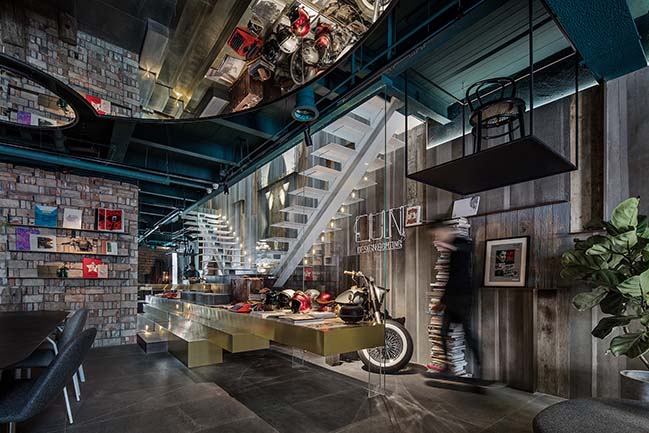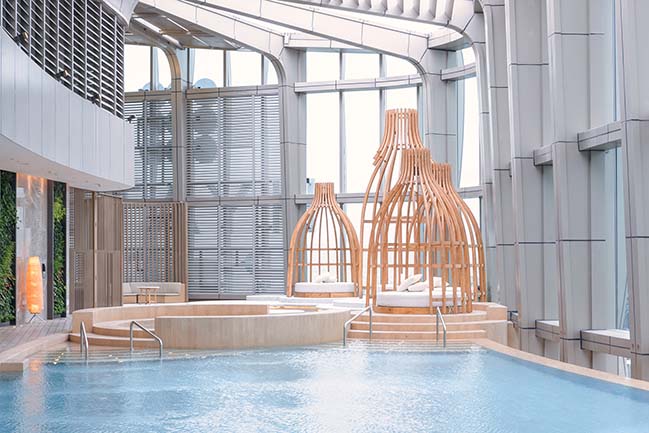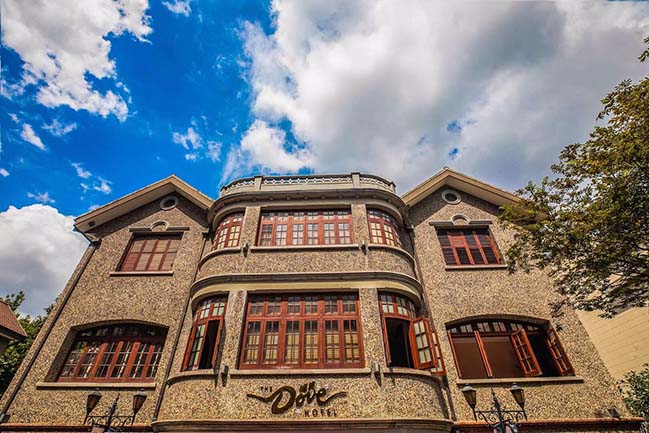10 / 15
2018
Helsinki and Shanghai based studio, PES-Architects, have completed their seventh project in China: the Fuzhou Strait Culture and Art Centre.

© Marc Goodwin
Architect: PES-Architects
Client: Fuzhou New Town Development Investment Group Co., Ltd.
Location: Mawei New Town, Fuzhou, China
Year: 2018
Area: Gross area 153,000 m2
Team: Pekka Salminen (chief designer), Martin Lukasczyk (project architect), Samuel, Hsuan-yu Shih (ceramic artist), Lai Linli (project manager)
Main design team: Li Wei (project coordinator), Guang Xiaojing (project manager), Yizhou Zhao, Masahide Nakane, Matti Kankkunen, Anna Blomqvist, Clara Juan, Uros Kostic, Antonio Barquinha, Martin Genet, Dou Jian
Local architect: Xu Zongwu, CCEDGC Co. Ltd.
Photography: Marc Goodwin, Zhang Yong
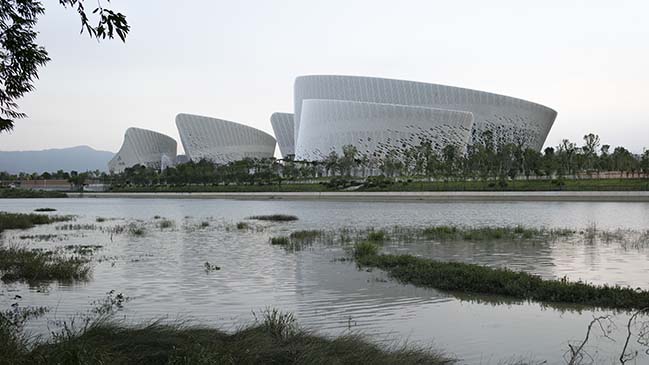
© Marc Goodwin
From the architect: Fuzhou is the capital and one of the largest cities in Fujian Province. It has been ranked one of the fastest growing metropolitan areas in the world. In 2013, the Fuzhou Government hosted an international invited competition for the Strait Culture and Art Centre with the goal of strengthening the cultural image of the city and the Mawei New Town development area.

© Zhang Yong
PES-Architects’ winning proposal takes inspiration from the petals of a jasmine blossom, the city flower of Fuzhou. The flower is manifested in the formal language and colour of the architecture takes inspiration from the petals of a jasmine blossom, the city flower of Fuzhou. The five jasmine petal venues — opera house (1600 seats), concert hall (1000 seats), multi-functional theatre, art exhibition hall and cinema centre — are linked by a Cultural Concourse and a large roof terrace. The roof terrace is accessible via two ramps from the Jasmine Gardens as well as from the Central Jasmine Plaza, providing a seamless connection from the complex to the riverfront of the Minjiang River. On the underground level, a promenade-like route along the Liangcuo flood river connects the landscape to the interiors, as well as providing a connection between the metro station and the Centre.
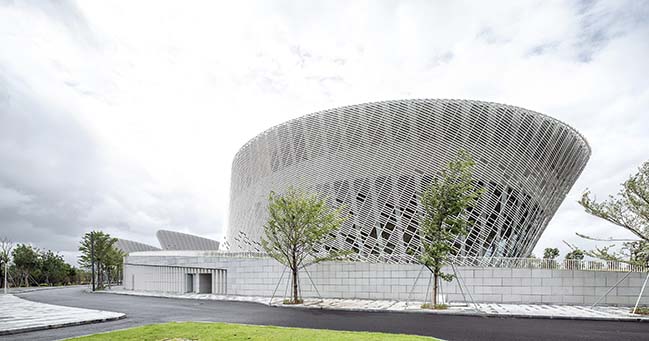
© Zhang Yong
Pekka Salminen, Founder of PES-Architects describes the scheme: “Dividing the large complex into smaller units gives the Centre a more human scale and makes it easy for users to navigate both indoors and outdoors. Each building has a core area — a semi-public, curved gallery that follows the curvature of the main façade — that integrates the public interior space with the landscape of the Jasmine Gardens around the building and further with the Mahangzhou island natural reserve in front of the Centre.”
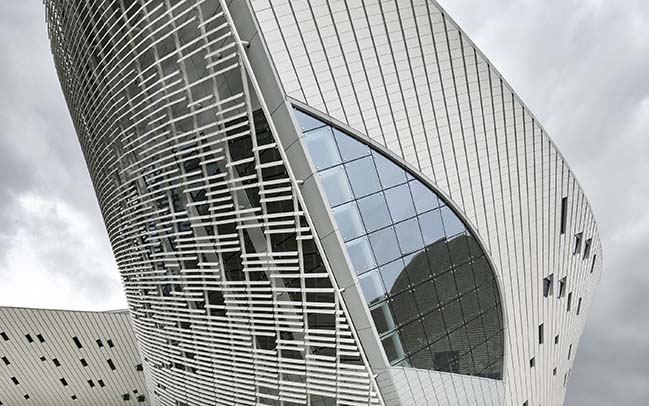
© Marc Goodwin
Ceramics - Ceramic is used as the project’s main material due to its significance in the historical context of the maritime Silk Road trade connection between China and the rest of the world. PES-Architects worked with Taiwanese ceramic artist Samuel Hsuan-yu Shih to design the artistic ceramic interior for two main auditoriums according to acoustical demands, using the legendary “China White” material and new technology. All façades are clad with white ceramic tiles and louvres, while both the opera hall and concert hall showcase this cultural material in innovative and creative ways in the acoustic wall surface.
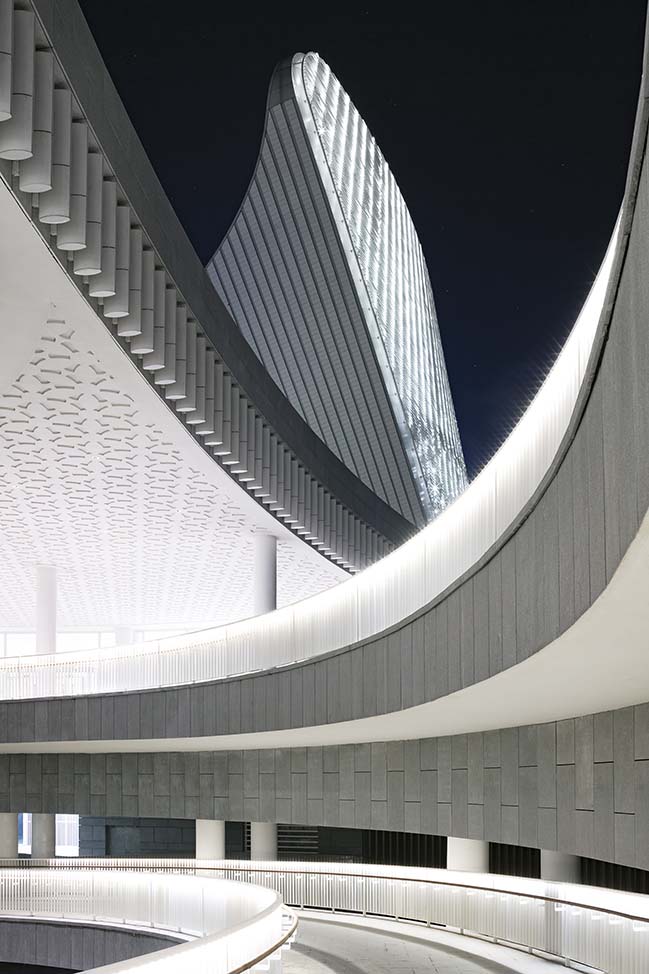
© Marc Goodwin
The interior surfaces of the opera hall and concert hall are clad with topographical ceramic panels. Based on extensive studies carried out with the acousticians, two types of acoustic panels were developed: an engraved panel and a mosaic tile panel. Both panels are adaptable to the topographical surfaces that are required to achieve high quality acoustics, as well as the visual language of the design.

© Marc Goodwin
The Multipurpose Hall is designed for a 700 seat audience. The walls are clad with solid CNC cut bamboo blocks, shaped according to the acoustic needs. The roof is equipped with a flexible cable net ceiling to enable a flexible usage of lighting and other technical equipment.
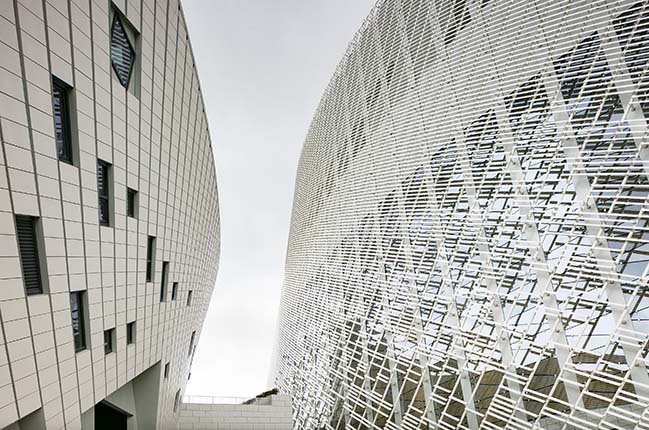
© Marc Goodwin - The back side of the buildings is clad with 80x40cm large ceramic plate elements.

© Marc Goodwin - The main entrance Concourse Lobby is an open space to be used for cultural activities. The so called “Mushroom Columns” are hosting elevators and ventilation equipment. “Sky Blossoms” in the lobby ceiling are introducing daylight and create a connection between the ground level and the roof terrace above.
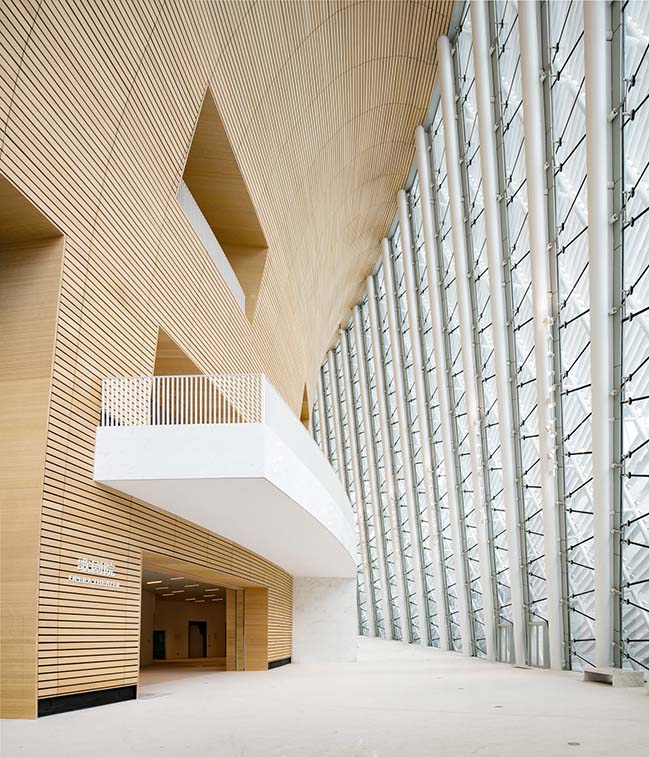
© Marc Goodwin - The Curved Galleries double-curved interior wall surfaces are clad with bamboo profiles. These gallery spaces can be used for public activities. From here the visitors will enter into the five venues
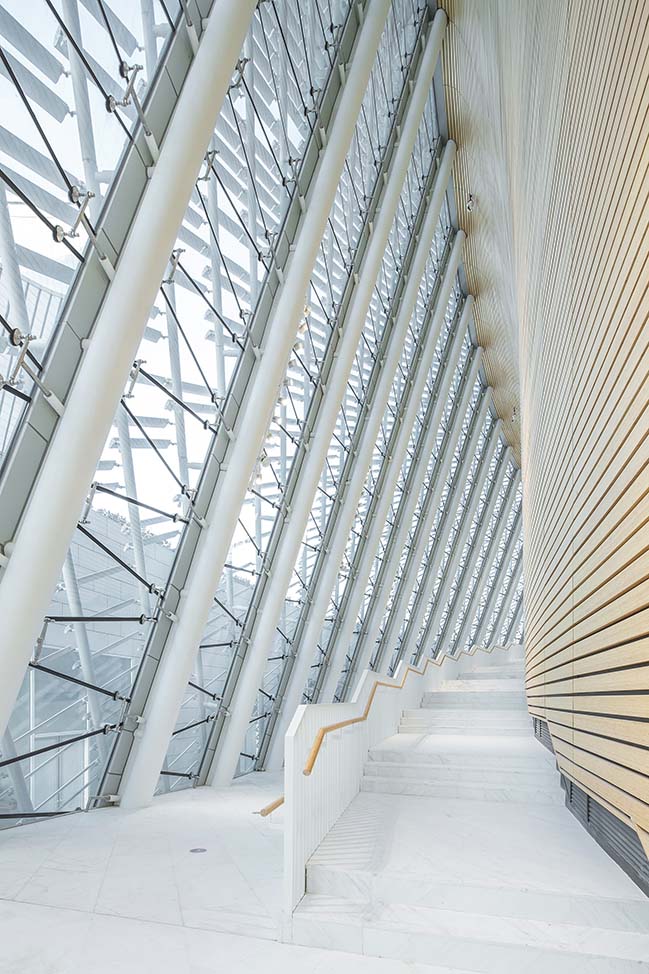
© Zhang Yong - The main entrance levels to the venues can be accessed via stairs from the Curved Galleries
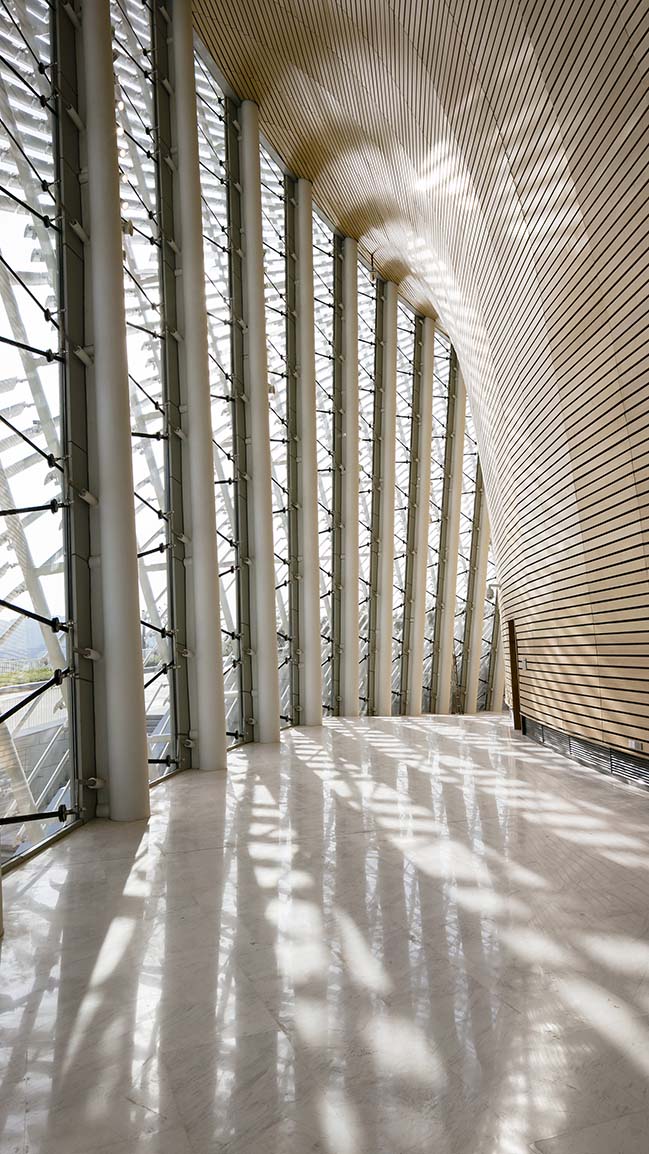
© Marc Goodwin - The sunlight entering the Curved Galleries is cut by the exterior ceramic louvers.
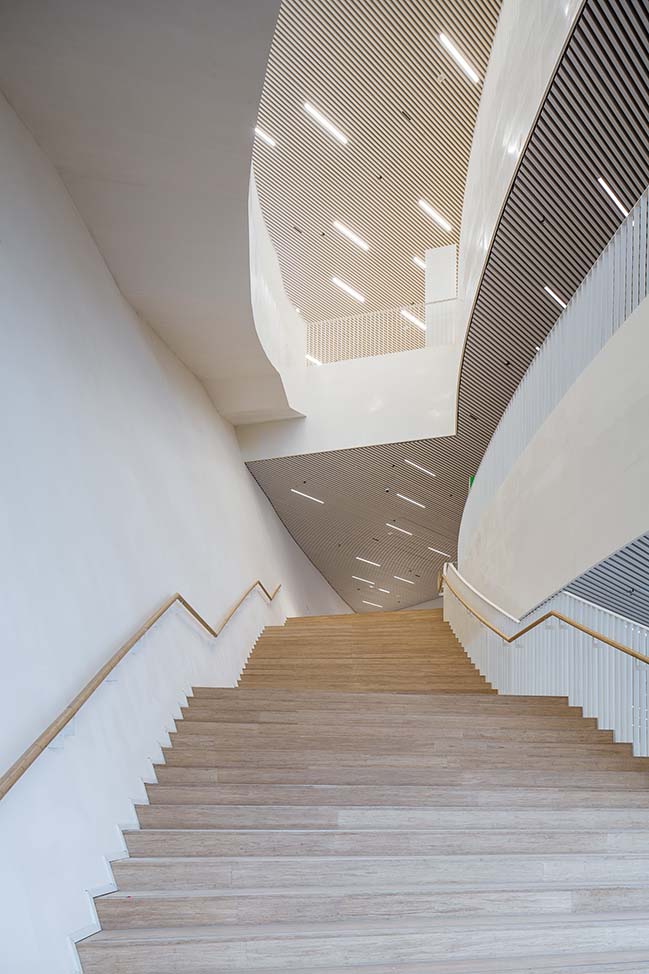
© Zhang Yong - For the Opera Hall and the Multipurpose Hall additional foyer spaces are leading to the upper balconies. The floor material in these more secluded spaces is solid bamboo.
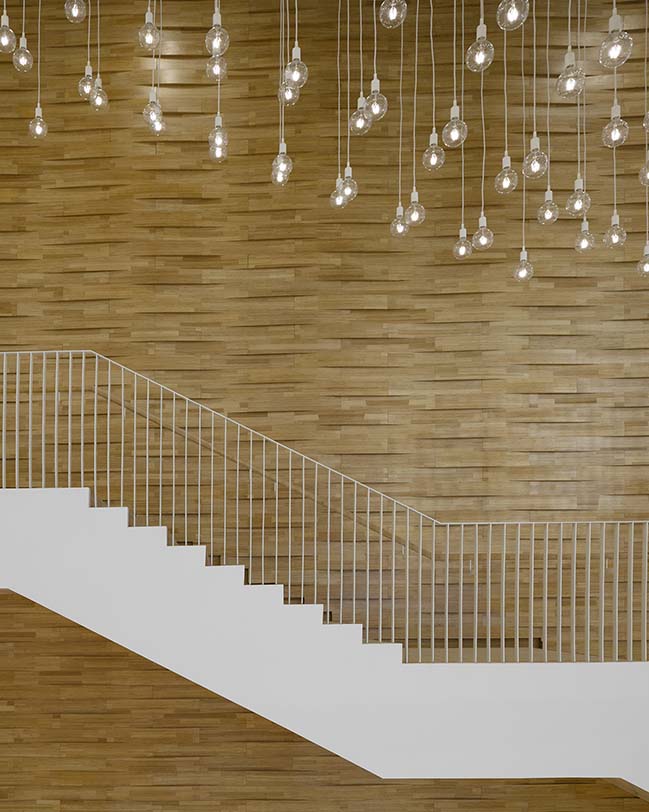
© Marc Goodwin - The Multipurpose Hall foyer walls are partly clad with solid CNC cut bamboo material, as a reference to the interior design of the hall.
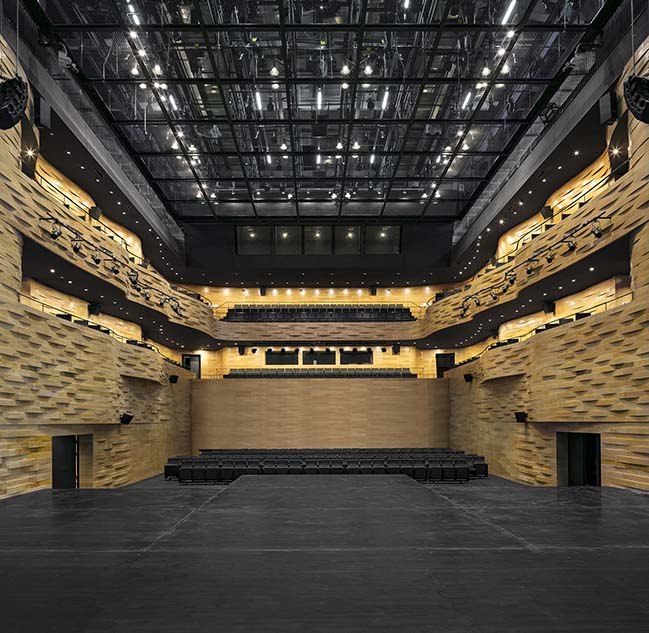
© Marc Goodwin - The Multipurpose Hall is designed for a 700 seat audience. The walls are clad with solid CNC cut bamboo blocks, shaped according to the acoustic needs. The roof is equipped with a flexible cable net ceiling to enable a flexible usage of lighting and other technical equipment.
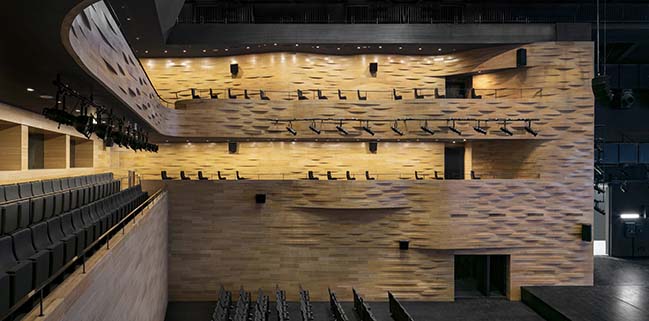
© Marc Goodwin - The main stalls seating area in the Multipurpose Hall is retractable to enable a standing audience and even-level functions.
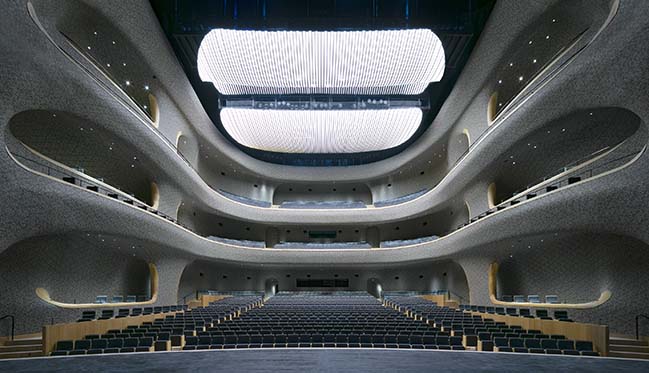
© Marc Goodwin - The Opera Hall is designed for a 1600 seat audience. The shape is fully generated with the help of acoustic scripting tools, and the complex 3000m2 double-curved surface is clad with about 1.5 million custom developed ceramic tiles.
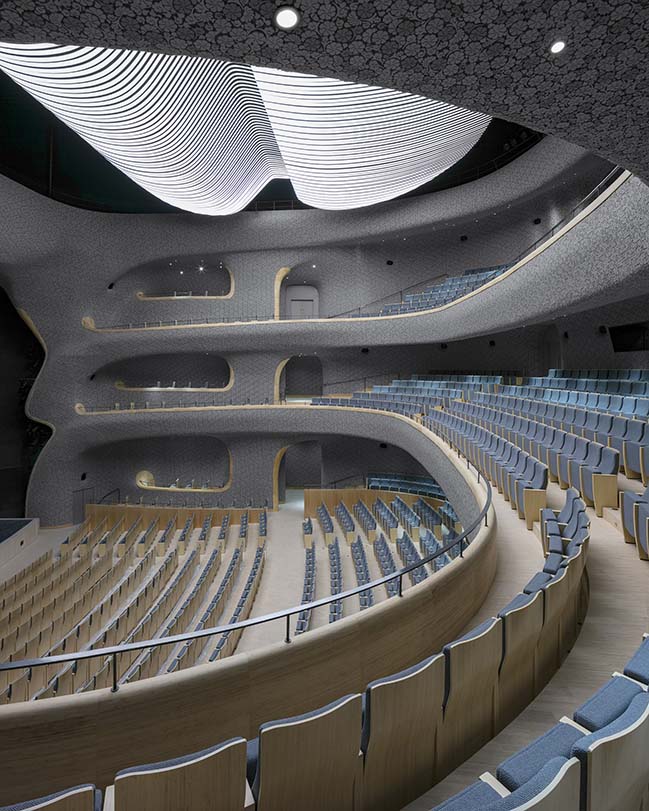
© Marc Goodwin - The ceramic tile surfaces in the Opera Hall are combined with solid bamboo parts. The ceiling reflector is made of acrylic, back-lit by white, dimmable LED lighting.
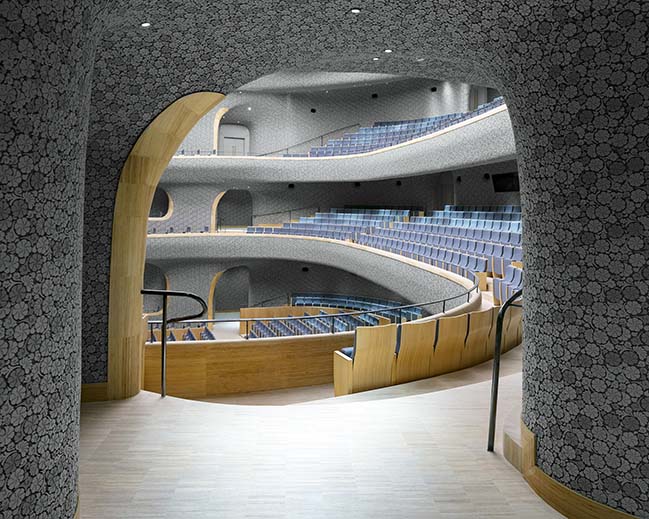
© Marc Goodwin - The complex geometry of the Opera Hall is continued to the entrance corridors, creating a homogenously connected double-curved skin.

© Marc Goodwin - The side balconies in the Opera Hall provide for intimate spaces, embraced by the elaborate double-curved acoustic surface.
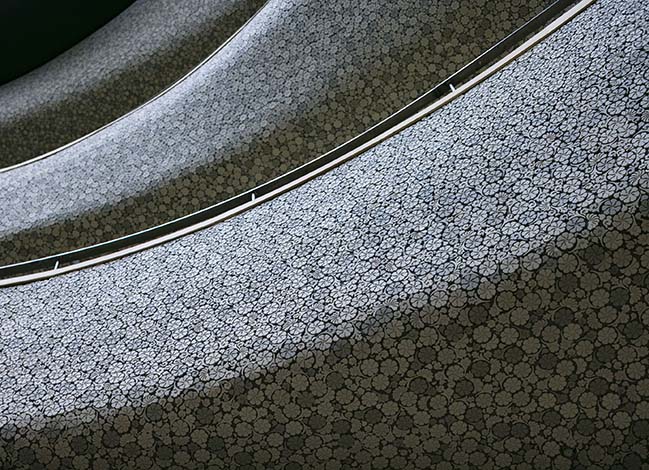
© Marc Goodwin - The free form acoustic surfaces of the Opera Hall are fully clad with custom developed ceramic tiles. There are 13 different tile types, creating a floral pattern, inspired by the Jasmine, the city flower of Fuzhou.
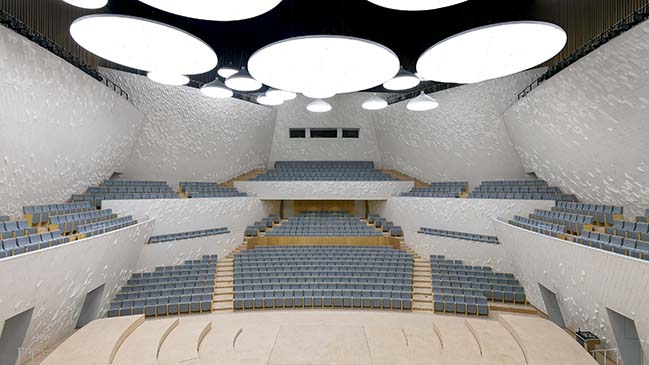
© Marc Goodwin - The Concert Hall is designed for a 1000 seat audience. Its walls are in the large scale composed of fractions of sphere surfaces, facing the audience seating area, and providing for the most functional acoustical shaping of the room.
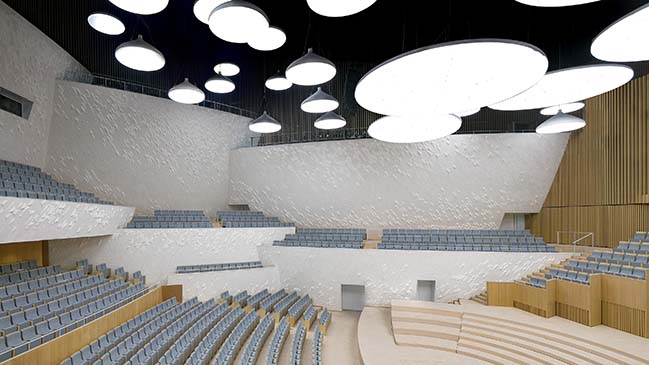
© Marc Goodwin - The sphere fragment walls of the Concert Hall are clad with white custom designed ceramic tiles. The ceramic tile are combined with solid bamboo material. The ceiling reflectors “Light Cloud” consist of back-lid acrylic surfaces.

© Marc Goodwin - The stage floor of the Concert Hall as well as the back walls of the stage and choir balcony are made of solid bamboo material.
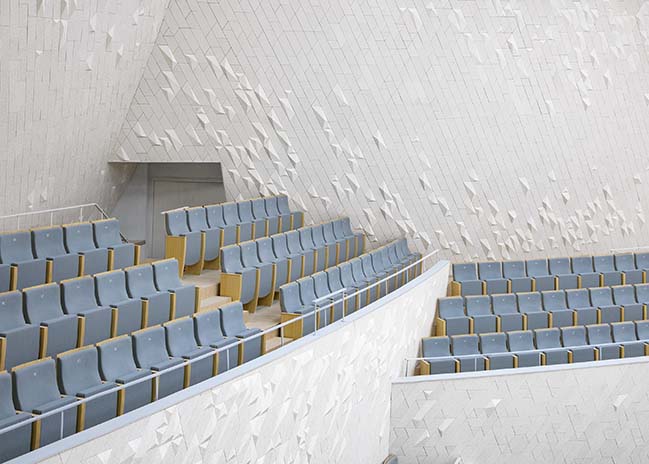
© Marc Goodwin - The pattern of the ceramic tiles in the Concert Hall is a result of a complex acoustic script, developed to define the exact location of smooth/ reflective surfaces compared to rough/ diffuse surfaces.
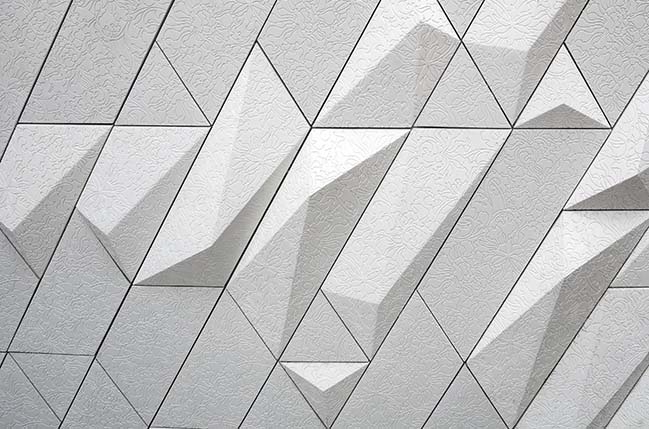
© Marc Goodwin - The “China White” ceramic tiles in the Concert Hall are CNC engraved with a floral pattern, inspired by the peony flower, the national flower of China since the Qing Dynasty.
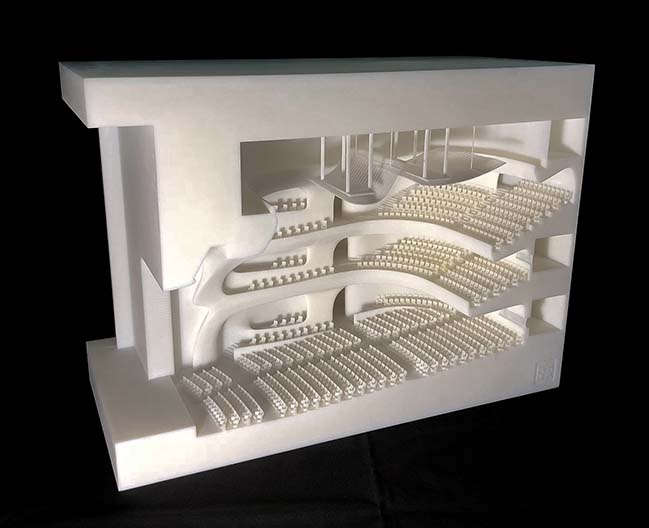


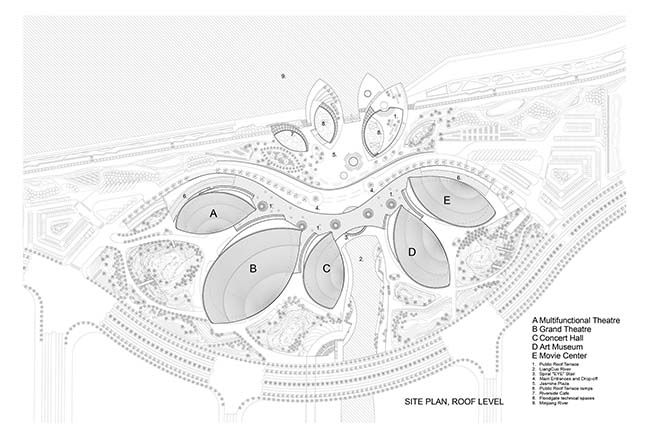
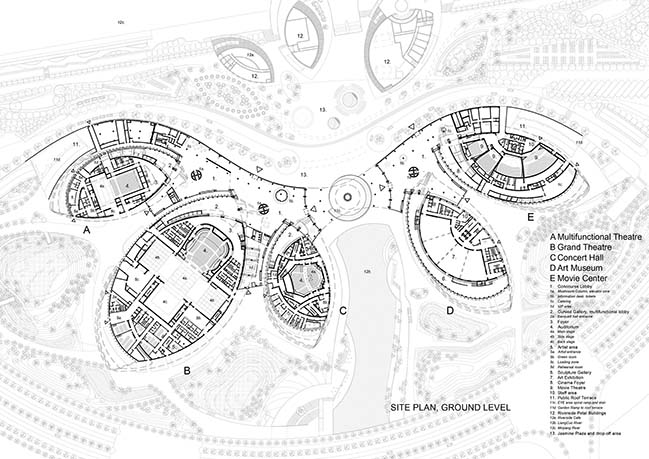
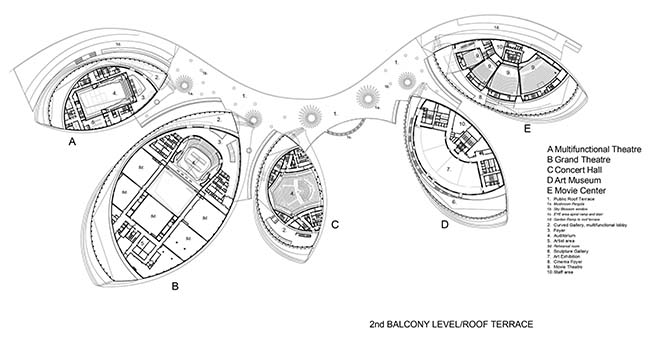

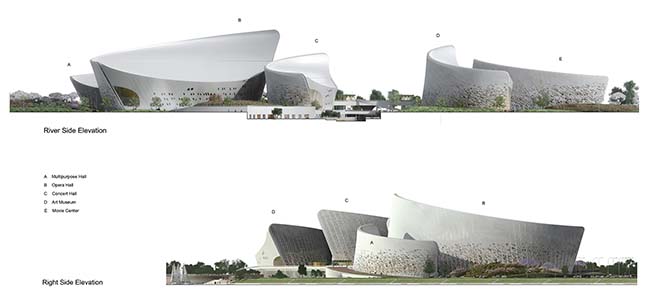


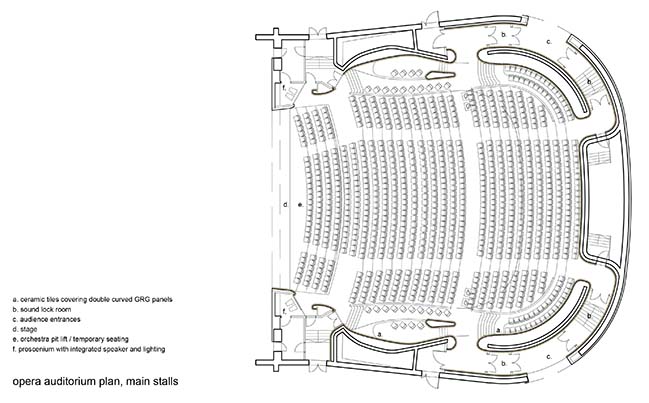
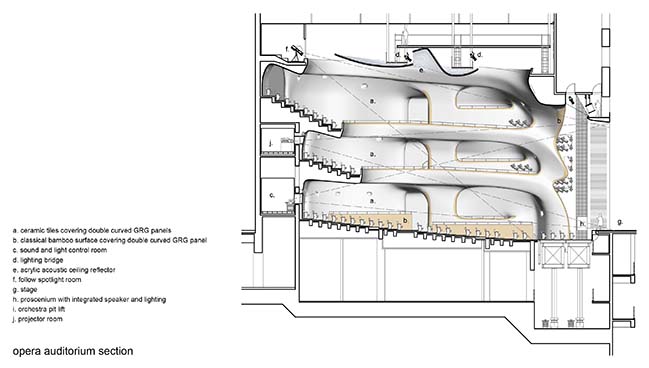
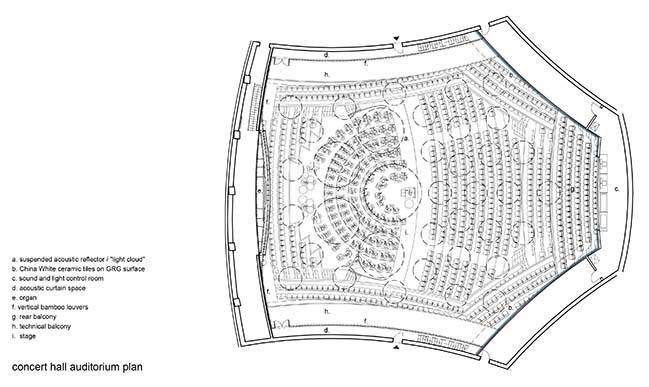
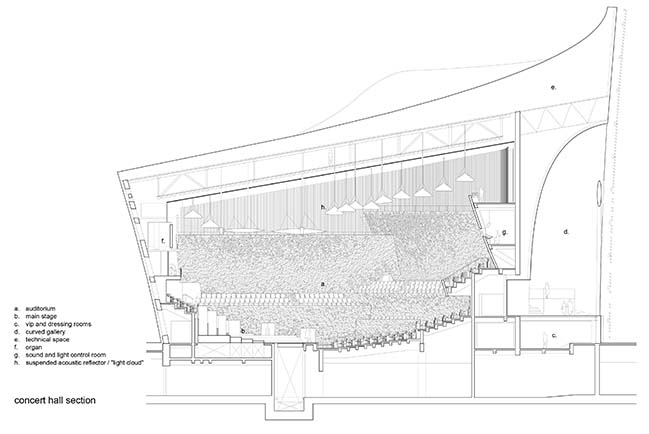
Fuzhou Strait Culture and Art Centre by PES-Architects
10 / 15 / 2018 Helsinki and Shanghai based studio, PES-Architects, have completed their seventh project in China: the Fuzhou Strait Culture and Art Centre
You might also like:
Recommended post: Restoration of Pi des Català Tower by Marià Castelló Architecture
